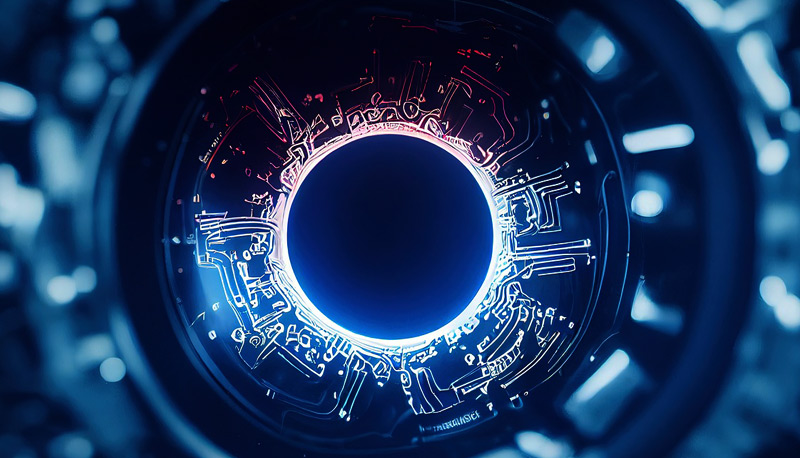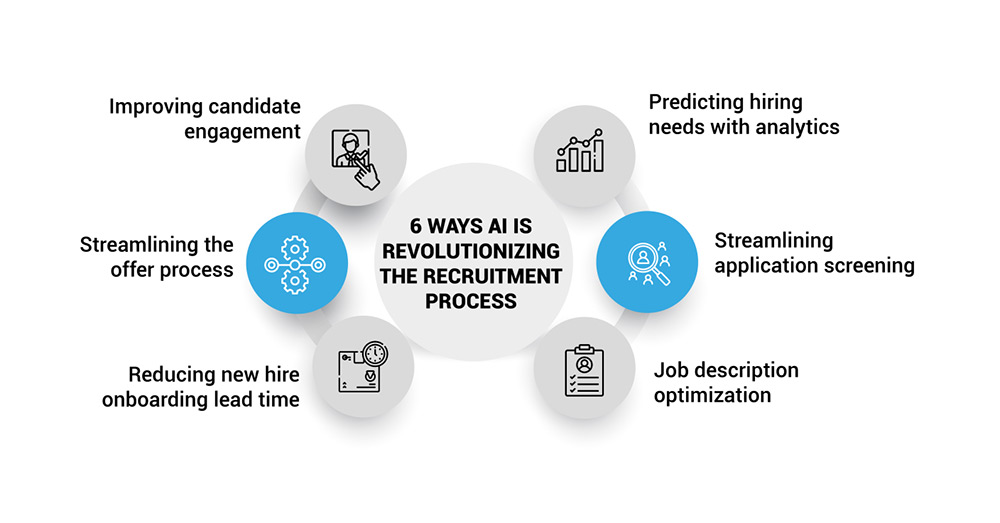
In today's competitive talent market, finding and hiring the right candidates quickly is crucial for organizations. While the traditional recruitment process involves time-consuming manual tasks like reviewing resumes, scheduling interviews, and onboarding new hires, AI technologies are helping reduce the time taken at various stages.
Artificial intelligence and machine learning technologies have significantly transformed various business processes across industries. One such area that has been impacted is recruitment and talent acquisition.
Traditionally, the recruitment lifecycle from sourcing candidates to onboarding new hires was a lengthy and resource-intensive process for companies. However, with advances in AI, many organizations have been able to streamline and accelerate their hiring using these innovative technologies. In this article, we will explore how AI is being leveraged to optimize the recruitment process and whether it is indeed helping to reduce time-to-hire.
Major Roadblocks in Recruitment
Here are some major roadblocks that recruiters often face:
-
Attracting top talent
In tight job markets where jobs are plentiful and workers have more options, it can be difficult for recruiters to attract top talent. Candidates have plenty of opportunities to choose from and may lose interest if a company does not respond quickly or provide a positive candidate experience. Recruiters must work to promote their company's benefits, culture, values and opportunities to stand out. Leveraging AI and data can help streamline processes and improve the candidate experience.
-
Managing bias
Unconscious biases can influence decisions and limit diversity if not controlled. Recruiters must be aware of their own biases and develop objective, skills-based criteria for evaluating candidates. Using tools like blind resume screening and structured interviews can help reduce bias. AI shows promise in evaluating candidates solely based on relevant qualifications to further reduce bias. However, biases can still exist in the underlying data, so approaches need review.
-
Administrative burdens
Sourcing candidates, screening high volumes of applications, scheduling interviews and more admin tasks can consume significant recruiter time. With tight deadlines and ongoing needs, administrative activities can impede strategic recruiting work. Integrating applicant tracking systems and AI tools that can source candidates, screen resumes, schedule interviews and more can help automate repetitive tasks and free up time.
-
Measuring success
It is difficult for recruiters to quantify their impact and ROI. Defining and tracking the right metrics is a challenge, from time-to-fill to retention to qualitative assessments of hire quality and cultural fit. Access to talent acquisition data and analytics enables recruiters to evaluate sources, refine processes and understand what makes for a successful hire to optimize outcomes over time.
-
Keeping pace with change
Labor markets, candidate expectations, compliance requirements, technologies and more are constantly evolving. Recruiters must continually research industry trends, learn new strategies, tools and skills, and adapt approaches accordingly just to maintain effectiveness. Those who incorporate data and technology into strategic planning can more nimbly respond to change for ongoing success.
In summary, recruiters face numerous roadblocks to be addressed through strategic planning, integration of technology and data analytics, process optimization, unconscious bias mitigation and more. Those who leverage artificial intelligence, metrics and continuous learning may be best positioned to overcome challenges and deliver results.
How AI is Revolutionizing the Recruitment Process
Let's take a deeper look at how AI is enabling faster and more efficient recruitment.

-
Predicting hiring needs with analytics
One of the initial steps in recruitment is predicting future hiring needs. Traditionally, talent acquisition teams relied on past trends and manual analysis to forecast openings. However, with AI, hiring managers can leverage predictive analytics to gain deeper insights.
AI algorithms can analyze multiple data points like employee attrition rates, business growth projections, skills inventory, and historical hiring patterns. Based on correlations found in this data, AI predicts demand trends for specific skills and competencies. This helps recruitment teams devise proactive strategies to fill skills gaps before they actually impact work.
For example, an AI model may detect that the attrition rate of software engineers is higher than other roles due to current market demands. It can then suggest ramping up college campus hiring for the next recruiting season. Such advanced analytics allow organizations to plan recruiting activities more meticulously.
-
Managing bias
Unconscious biases can influence decisions and limit diversity if not controlled. Recruiters must be aware of their own biases and develop objective, skills-based criteria for evaluating candidates. Using tools like blind resume screening and structured interviews can help reduce bias. AI shows promise in evaluating candidates solely based on relevant qualifications to further reduce bias. However, biases can still exist in the underlying data, so approaches need review.
-
Streamlining application screening
One of the biggest bottlenecks in the recruitment cycle is sifting through applications to identify top candidates. Manually reviewing each resume and cover letter is tedious and inefficient for recruiters.
Here, AI-powered screening tools prove useful. They can quickly filter thousands of resumes based on predefined skills and qualifications. Using techniques like NLP, AI systems extract relevant data from documents and highlight profiles closely matching the job requirements.
Keyword matching, skill similarity analysis, standardized scoring - these automated screening methods leave little room for human error or bias. They also free up recruiters' time, allowing them to focus on outreach, interviewing and assessing soft skills which AI still cannot evaluate.
-
Job description optimization
Another area where AI is helping optimize the hiring process relates to job postings. By leveraging data analytics, AI can A/B test different versions of job descriptions to identify the most attractive variant.
Metrics like application rate, time-to-fill, and click-through rate are captured for each version. Based on performance, the AI model intelligently refines wordings, emphases and fields to appeal to a wider talent pool. This tailored approach addresses demand more effectively compared to generic descriptions.
Additionally, AI ensures job postings are written inclusively using gender-neutral language. This moves away from unintentional biases, welcoming diverse candidates into the process. Optimized, inclusive descriptions lead to a larger, more qualified applicant pool in less time.
-
Improving candidate engagement
Artificial intelligence and machine learning can analyze candidate behavior on company career sites and social media to enhance the user experience.
AI understands which job details attract more attention. It then proactively engages qualified profiles by personalizing outreach over various digital channels. Timely, relevant communication keeps candidates interested in the role and organization.
For applicants, AI recommends additional roles to explore based on their profiles. It also provides automatic status updates to build trust. Such personalized touchpoints maintain high engagement without overburdening recruiters. As a result, opportunities are filled faster as the best fit remains actively involved in the hiring funnel.
-
Streamlining the offer process
After initial screening and interviews, assessing the cultural fit of candidates is a crucial step. AI comes into play here as well by leveraging sentiment analysis of interview feedback.
It applies NLP techniques to understand the tone and expressions used in transcripts, comments and survey responses. Based on such insights, AI can accurately gauge interpersonal compatibility along with hard skills. This enables data-backed selection of the best match for organizational values.
Once a candidate is identified, AI automates offer generation. It plugs in negotiated details like compensation, location etc into standard templates within minutes. For the candidate, receiving a customized letter in record time signifies the employer's efficiency. Faster offers mean less time spent filling critical vacancies.
-
Reducing new hire onboarding lead time
The final phase where AI streamlines recruitment is onboarding. Setting up HR systems and integration takes a backseat as AI steps in to simplify the entire process for new employees.
Intelligent chatbots can answer queries about company policies, benefits, IT setup and other related questions autonomously. This frees HR teams to focus on the human touchpoints of onboarding such as culture integration rather than addressing repetitive administrative tasks.
Auto-populating IT systems, pre-loading payroll details, generating complete paperwork - AI handles it all at machine speed. As a result, new hires can begin contributing value earlier with minimal lag between joining and productivity. Shorter lead times are a win-win for both individuals and organizations.
Ethical Considerations and Maintaining Human Touch in the Hiring Process
Let’s explore the ethical considerations involved in AI-driven hiring:
-
Planning Policies Regarding AI in Hiring
No organization should let AI simply take over the hiring process without human oversight. Leaders must develop strong policies focusing on transparency, fairness and accountability to ensure AI is just a tool that assists humans rather than replaces them. Developing ethical policies helps everyone understand how AI fits into the hiring process.
-
Eliminating Human Biases from AI Systems
While computers themselves do not hold biases, humans programming them can sometimes instill biases. When choosing an AI hiring platform, ask what has been done to protect against biases in the algorithms, such as insisting on using psychological profiling and predictive analytics to eliminate biases involving gender, race, age or socioeconomic status.
-
Remembering That Humans Are Core to Hiring
AI cannot replace what dedicated HR professionals provide. People understand concepts such as integrity, ethics and morality from a human perspective in ways AI never will. Empathy is important when considering hiring details. Additionally, only live interviews can reveal candidates' interpersonal skills that are ideal for work environments. AI is just a helpful tool - people must evaluate candidates as individuals.
Conclusion
To Conclude, by automating mundane tasks and adding a predictive edge, AI has significantly reduced the time spent across all stages of recruitment. With data-driven decisions and personalized engagement, hiring top talent is no longer a lengthy endeavor for forward-thinking companies. AI will continue optimizing the process to help recruitment scale efficiently in future talent shortages as well.



